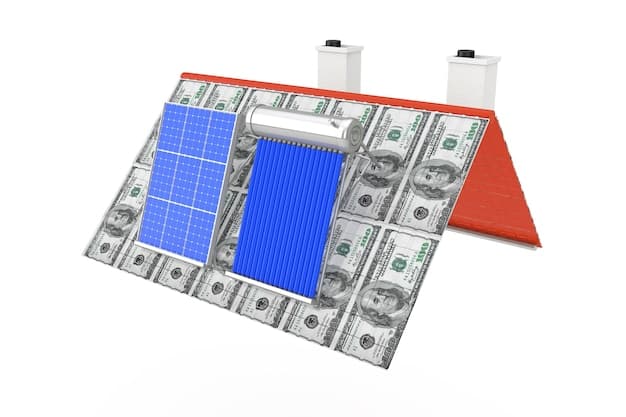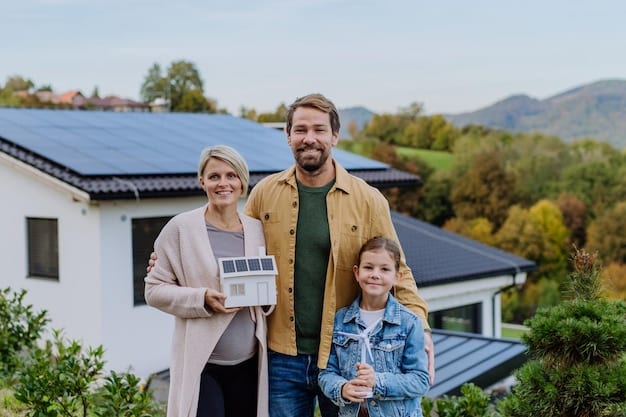Renewable Energy Tariffs: Your 2025 Cost Navigation Guide

Understanding Renewable Energy Tariffs: A 2025 Guide to Navigating Costs offers a comprehensive overview of the pricing structures for renewable energy, helping consumers and businesses in the US make informed decisions about their energy consumption and investments in sustainable sources.
Navigating the world of renewable energy can be complex, especially when it comes to understanding the costs. This guide, Understanding Renewable Energy Tariffs: A 2025 Guide to Navigating Costs, breaks down everything you need to know about renewable energy pricing structures, empowering you to make informed choices.
Understanding the Basics of Renewable Energy Tariffs
Renewable energy tariffs are the pricing mechanisms used by energy providers to charge consumers for electricity generated from renewable sources like solar, wind, and hydropower. Understanding these tariffs is crucial for individuals and businesses looking to reduce their carbon footprint and potentially save money on their electricity bills.
These tariffs can vary significantly depending on several factors, including the location, the type of renewable energy source, and the specific utility company. By gaining a solid understanding of the basic principles behind these tariffs, you can better evaluate your options and choose a plan that aligns with your energy needs and financial goals.
Types of Renewable Energy Tariffs
There are several types of renewable energy tariffs available to consumers. Each type has its own set of benefits and drawbacks.
- Feed-in Tariffs: These tariffs pay consumers for the excess renewable energy they generate and send back to the grid.
- Net Metering: Similar to feed-in tariffs, net metering allows consumers to offset their electricity usage with the renewable energy they generate.
- Green Pricing Programs: These programs allow consumers to purchase a percentage of their electricity from renewable sources, often at a premium.
- Community Solar Programs: These programs enable multiple customers to share the benefits of a single solar installation.
Ultimately, selecting the right tariff requires careful consideration of your energy consumption patterns, your location, and the available options. Stay informed about your local utility’s offerings and consult with energy experts to make the best choice.
Factors Influencing Renewable Energy Tariff Rates
Several factors influence the rates associated with renewable energy tariffs. These factors range from government policies, technological advancements to grid infrastructure.
Understanding these influences can help you anticipate changes in tariff rates and make more informed decisions about your energy investments. By staying informed, you can better navigate the complexities of the renewable energy market and optimize your energy costs.

Government Policies and Incentives
Government policies and incentives play a significant role in shaping renewable energy tariff rates. Subsidies, tax credits, and mandates can all impact the cost of renewable energy and, consequently, the tariffs charged to consumers.
Policies like the Investment Tax Credit (ITC) and state-level Renewable Portfolio Standards (RPS) can significantly lower the upfront costs of renewable energy projects and incentivize utilities to offer more competitive tariff rates.
Technological Advancements and Infrastructure
Technological advancements have drastically reduced the cost of renewable energy generation. Improved solar panel efficiency, more powerful wind turbines, and advanced energy storage solutions have all contributed to making renewable energy sources more affordable. However, existing grid infrastructure might require upgrades to fully accommodate new renewable energy sources, this can also influence the tariff costs.
These advancements directly impact the cost of renewable energy, influencing the tariff rates offered to consumers. It’s expected that technology will continue its forward march and costs for renewable energy will become even more affordable and the grid infrastructure will keep adapting.
In conclusion, multiple elements affect renewable energy tariff costs and it is essential to be informed and stay up to date to make the best decisions.
Comparing Renewable Energy Tariffs: What to Look For
Comparing renewable energy tariffs can seem daunting, but focusing on a few key areas will make the process more manageable. Knowing what to look for enables you to make the best decision for your energy consumption.
By thoroughly evaluating these factors, you can confidently select a renewable energy tariff that meets your needs and contributes to a more sustainable future. It’s essential to choose well and always be informed about changes in the market.
- Price per Kilowatt-Hour (kWh): The most basic metric is the price you pay for each unit of electricity.
- Contract Terms: Check the length of the contract, any early termination fees, and whether the rate is fixed or variable.
- Renewable Energy Content: Verify the percentage of electricity that comes from renewable sources.
- Transparency and Customer Service: Look for providers that are transparent about their pricing and have a good track record of customer service.

The Impact of Location on Tariff Availability and Pricing
Your location plays a significant role in the availability and pricing of renewable energy tariffs. Different states and regions have varying regulations, incentives, and renewable energy resources. Depending on your location, your tariff prices might vary.
These factors can significantly impact the cost and availability of renewable energy tariffs in your area. By understanding the local landscape, you can better navigate your options and make informed decisions about your energy consumption and investments in renewable energy.
State and Local Policies
State and local policies can significantly affect the availability and pricing of renewable energy tariffs. States with strong renewable portfolio standards (RPS) often have more competitive tariff rates and a wider range of options.
For example, states like California and New York, which have ambitious renewable energy goals, offer robust incentive programs and supportive regulatory frameworks that encourage the growth of the renewable energy market and drive down costs for consumers.
Access to Renewable Resources
The availability of renewable resources, such as solar and wind, also impacts tariff pricing. Regions with abundant sunshine or strong winds tend to have lower renewable energy costs. These regions commonly have competitive tariff prices for renewable energy.
For example, states in the Southwest, with plentiful sunshine, often have lower solar energy costs, while states in the Great Plains, with strong winds, tend to have more competitive wind energy tariffs.
In conclusion, location is a make or break factor for tariff options and pricing. Make sure to check what is available in your region to make the best decision.
Forecasting Renewable Energy Tariff Trends for 2025
Looking ahead to 2025, several trends are expected to shape renewable energy tariffs. Technological advancements, policy changes, and evolving consumer preferences will all play a role in determining the future of renewable energy pricing.
These trends include the increasing adoption of battery storage, the rise of smart grids, and the growing demand for green energy options. By anticipating these changes, you can better prepare for the future and make informed decisions about your energy investments.
The Role of Battery Storage
Battery storage technologies are becoming increasingly affordable and efficient, which is expected to have a significant impact on renewable energy tariffs. Battery storage allows consumers to store excess renewable energy generated during peak production times and use it later when demand is high.
This reduces reliance on the grid and lowers energy costs, making renewable energy tariffs even more competitive. Battery storage is expected to play a key role in firming up renewable energy supplies and moderating tariff costs.
The Expansion of Smart Grids
Smart grids are advanced electricity networks that use digital technology to improve efficiency, reliability, and sustainability. They enable real-time monitoring of energy usage, optimize grid operations, and facilitate the integration of renewable energy sources.
As smart grids become more widespread, they will enable more dynamic and flexible tariff structures, allowing consumers to respond to changing energy prices and demand patterns. This also enables the providers to be more efficient with their resources and lower rates.
In summary, as we move forward we can expect more technology and that will likely impact rates. It is essential to keep abreast of all changes.
Making the Switch: Steps to Adopt Renewable Energy Tariffs
Adopting renewable energy tariffs involves a few key steps, from assessing your energy needs to selecting the right provider. By following these steps, you can seamlessly transition to renewable energy and start enjoying the benefits of clean, sustainable power.
These final steps help ensure a smooth and successful transition to renewable energy, allowing you to reduce your carbon footprint and potentially save money on your electricity bills. It’s always better to choose well and be informed.
Assess Your Energy Needs
Before switching to a renewable energy tariff, assess your energy consumption patterns and needs. Review your past electricity bills to determine your average monthly usage and identify peak demand times.
This information will help you determine the right size and type of renewable energy system for your home or business and select a tariff that aligns with your energy needs.
Select a Renewable Energy Provider
Research and compare different renewable energy providers in your area. Look for providers that offer a variety of tariff options, transparent pricing, and a strong commitment to customer service.
Check customer reviews and ratings to get a sense of the provider’s reputation and reliability. Don’t hesitate to reach out to multiple providers and ask questions about their tariffs, renewable energy sources, and contract terms. You’ll be better off with the right provider.
| Key Point | Brief Description |
|---|---|
| 💡 Tariff Types | Feed-in, Net Metering, Green Pricing, and Community Solar. |
| 💸 Influencing Factors | Government policies, tech, and grid infrastructure. |
| 📍 Location Matters | State policies and access to renewable resources affect pricing. |
| 🌱 Future Trends | Battery storage integration and smart grid expansion. |
Frequently Asked Questions
A tariff is a pricing mechanism for electricity from renewable sources like solar, wind, and hydro, potentially lowering your carbon footprint and energy bills. It’s your green electricity price.
Feed-in tariffs pay you for excess renewable energy you send back to the grid. As you produce more energy than you need, you send it back to the grid and in return get paid to do so.
Rates are influenced by government policies, tech advancements, and grid infrastructure development. Government policies often lower the costs, with new technology being adopted and old infrastructure being replaced.
Location matters because state policies and access to renewable resources affect availability and pricing. For example, states like California and New York have better tariff options because of their policies.
Affordable battery storage can store excess energy, reduce grid reliance, and make tariffs more competitive. As battery technology continues to improve, energy production from solar sources becomes increasingly optimized.
Conclusion
Understanding renewable energy tariffs is essential for consumers in 2025 who want to embrace sustainable energy solutions. By carefully evaluating the different types of tariffs, considering the factors that influence their rates, and staying informed about future trends, you can make informed decisions that align with your energy needs and environmental goals.





